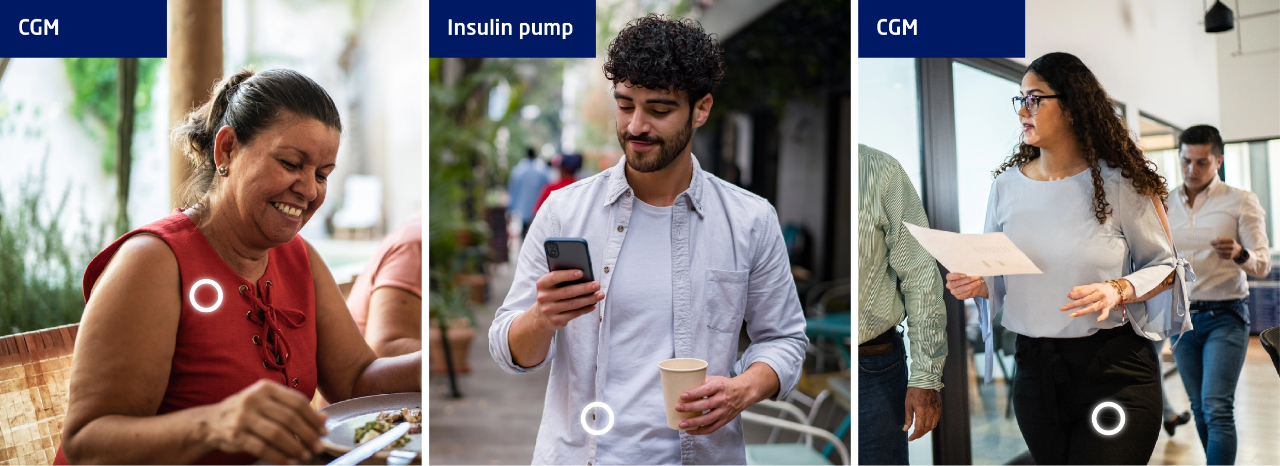Diabetes stigma in a digital world: What CGMs, celebrities, and communication have in common
By Amy Tenderich, MA
6 min read

Unfortunately, people with diabetes have had to deal with stigma and misinformation about their condition for a long time. Most people I know with type 2 diabetes have faced stereotypes about being lazy or gluttonous and have been made to feel their condition is their own fault.1 Many people diagnosed with type 1 diabetes as kids may grow up feeling self-conscious about their condition, and it may affect how consistently they self-manage.2 I’ve spoken to so many people with type 1 diabetes who felt ostracized by their peers for getting special treatment or needing to test blood sugar and take insulin at school.
In diabetes, preconceived notions abound—if you want more examples, just ask your patients. Whatever form it may take, diabetes stigma can be harmful. It can change people’s self-perception and may lead to poor or inconsistent diabetes self-management.1
As I see it, anything people can do to minimize stigma is a step toward managing diabetes with confidence, and in recent years I’ve seen 3 strategies that may help. Spoiler alert: Diabetes technology plays a role in all of them.
1. Keeping a low profile with discreet wearable tech
I was diagnosed with type 1 diabetes in my 30s, and it was a rude awakening to feel the gawking and judgmental stares I got from strangers when injecting my insulin in public. Sadly, this feeling of vulnerability is common; it can happen to people with diabetes anywhere that others can see their self-management.1
A person who works in a factory or on a sales floor may not be allowed to do finger sticks out in the open, and then they might be inconvenienced or feel embarrassed that they have to make frequent visits to the restroom. Someone wearing an insulin pump may hear remarks from well-meaning strangers that they’re “bionic,” or they might have to listen to others talk self-centeredly about how they’d hate to have such a condition.
I wish I could wave a magic wand and fix society’s insensitivity and misunderstandings about diabetes, but I can’t. Fortunately, some of today’s wearable diabetes technology may help people with diabetes feel less on display.
Many of today’s CGMs are relatively small, discreet sensors or even implantable ones, and some modern insulin pumps are small enough to be hidden under clothing.3,4 Many wearable devices may also be controlled via smartphone apps, letting users camouflage their diabetes management. If I’m out in public looking at my phone, I may as well be texting or watching cat videos—no one has to know I’m adjusting the dose on my insulin pump.
Preventing awkward encounters without missing a beat in self-management? That may strike a helpful balance for someone who’s cautious about keeping their diabetes out of public view.

For some people, concealing their CGM or insulin pumps may help them avoid feeling self-conscious about managing diabetes.5

Preventing awkward encounters without missing a beat in self- management? That may strike a helpful balance for someone who’s cautious about keeping their diabetes out of public view.
2. Achieving a sense of belonging through role models, empowerment, and community
Of course, no one with diabetes should have to feel judged or embarrassed about managing their condition.
So it’s been really encouraging to see people with big platforms talk publicly about their experiences with diabetes technology. You may have seen them—accomplished athletes, musicians, a reality TV show contestant who traveled the world while lugging her diabetes supplies in her backpack, and 2 different pageant winners who wore their pumps visibly on national TV. I’m so happy to see these people speaking out to help normalize living with diabetes.
I think these influential personas are helping facilitate the social acceptability of diabetes tech. I’ve encountered kids with diabetes who had been hesitant to wear an insulin pump or CGM but changed their minds when they saw one of their heroes wearing one. To me, it’s important for people in the diabetes community to see that anyone with this condition can aspire to live the life they choose.

Help your patients with diabetes seek out support and inspiration by pointing them toward online communities, diabetes advocacy groups, and celebrity influencers who speak publicly about living with diabetes.
Social support also plays a role in destigmatizing diabetes. Groups such as the Diabetes Link (for young adults with diabetes) and Children With DiabetesTM (for families of children with type 1 diabetes) can provide not only a place to learn about diabetes tech, but also a way to connect with each other and nurture a sense of belonging. Various apps for people with either type 1 or type 2 diabetes can help them plug into online support communities where they can get information, exchange stories, and pick up tech tips.
There’s even a national campaign run by the diaTribe Foundation called dStigmatize. It encourages advocates, health care professionals, and the media to take a pledge to use empowering language that may help shift dialogue away from the long-standing negativity around diabetes.6
Collectively, I think all of this support and empowerment makes a statement that diabetes is not a condition that calls for criticism or pity. We no longer have to feel ashamed or bear that stigma.

As a provider, you can be a voice of inspiration too:
- Practice empathy, not sympathy
Refer people with diabetes to social support structures
Encourage pride in your patients and support their choices to wear diabetes tech that helps them manage their condition openly
3. Removing stigma from the clinical conversation
The third way to counteract diabetes stigma may have to come from the professionals who work to treat it. Many people with diabetes feel their health care providers don’t always include them in the decision-making process. Sometimes bias from providers toward certain groups of people with diabetes may stop conversations about tech before they start.7,8
It's important to look at each patient as an individual and learn about what’s important to them, rather than lumping them into a group based on a demographic.7 Here’s what you can do as a provider to actively engage each patient and help set the table for a conversation about diabetes tech.
When in doubt, bring up the option of tech7
Anytime you see a patient who you think may be appropriate for diabetes technology, offer it as an option, even if you aren’t sure they’ll be open to it. Ask if they’d like to learn more about tech options early in the treatment process. You can frame the conversation using open-ended questions about how they see the tech fitting in with their self-management routine. People of all education levels and financial situations may appreciate your walking them through the possibilities.
Discuss diabetes tech evenhandedly8
Share the potential benefits and challenges of diabetes tech in detail, and be aware of how the tone you set may influence your patient’s decision. If you show optimism and enumerate the ways diabetes tech could help, your patients may match your level of engagement. If you present tech as a long shot, a hassle, or an afterthought, they may not show as much interest.
Ensure understanding8
Try illustrating your explanations of diabetes tech with examples relevant to your patients’ concerns. When you’re done explaining, ask them to summarize key concepts back to you. Invite patients to ask questions and encourage them to talk about their treatment goals. If they’re not sure about the real-world experience of using this type of tech, you can suggest that they research other people with diabetes who may be using it and sharing their stories with the community.
Remember, you have a chance to connect your patients with technology that may fit their needs and enhance their diabetes management. Help them make informed treatment decisions in an atmosphere that’s free of stigma.
I’m grateful to have had at least 2 providers who have been encouraging and helpful with diabetes tech. One guided me to a data logging app that I wouldn’t have found otherwise; he was also understanding when I felt burned out and told him I needed to take a break. Both providers have been extremely supportive in reviewing my diabetes data with me and helping make adjustments to my insulin routine. That kind of personalized care has been extremely motivating to me, and I think any person with diabetes would appreciate it.
Tech-up Follow-ups
- Think of a patient who has told you that they feel self-conscious about managing their diabetes in public, or who doesn’t self-manage consistently due to how they think others may see them.
- Identify some potential social support networks that you can refer them to, and/or identify a piece of low-profile diabetes tech that you think might help. Print or bookmark information about it to share with the patient.
- At your next visit with this patient, discuss some of your findings with them and see how they respond.

Amy Tenderich, MA
Santa Barbara, California
Amy is a journalist, nationally known patient advocate, and diabetes tech expert. She was the founder and editor of DiabetesMine.com and former Editorial Director of Diabetes & Patient Advocacy at Healthline Media. She organizes and hosts the biannual DiabetesMine Innovation Forums (Innovation Summit, D-Data ExChange) that connect patient and industry leaders. Amy also lives with diabetes, having been diagnosed with type 1 diabetes in 2003.
Amy Tenderich received a fee from Novo Nordisk for her participation.
–— Recommended for you –—

ARTICLE
How can we build on A1C? Looking at metrics that can help with daily glycemic control
A conversation about the practical applications of digital data and diabetes metrics such as TIR, GMI, and GRI, and how they may help patients take action in their self-management.
By Amy Hess-Fischl, MS, RDN, LDN, BC-ADM, CDCES and Amy Tenderich, MA | 10 min read
References
- Liu NF, Brown AS, Folias AE, et al. Stigma in people with type 1 or type 2 diabetes. Clin Diabetes. 2017;35(1):27-34. doi:10.2337/cd16-0020
- Brazeau AS, Nakhla M, Wright M, et al. Stigma and its association with glycemic control and hypoglycemia in adolescents and young adults with type 1 diabetes: cross-sectional study. J Med Internet Res. 2018;20(4):e151. doi:10.2196/jmir.9432
- Continuous Glucose Monitors (CGM). diaTribe Learn. December 2, 2014. Accessed August 2023. diatribe.org/continuous-glucose-monitors-cgm
- Insulin Pumps. diaTribe Learn. December 2, 2014. Updated October 7, 2021. Accessed August 2023. diatribe.org/insulin-pumps
- Pauley ME, Berget C, Messer LH, Forlenza GP. Barriers to uptake of insulin technologies and novel solutions. Med devices (Auckl). 2021;14:339-354. doi:10.2147/MDER.S312858
- Take Action. dStigmatize. Accessed August 2023. dstigmatize.org/action
- Agarwal S, Simmonds I, Myers AK. The use of diabetes technology to address inequity in health outcomes: limitations and opportunities. Curr Diabetes Rep. 2022;22(7):275-281. doi:10.1007/s11892-022-01470-3
- Entwistle V, Prior M, Skea ZC, Francis JJ. Involvement in treatment decision-making: its meaning to people with diabetes and implications for conceptualisation. Soc Sci Med. 2008;66(2):362-375. doi:10.1016/j.socscimed.2007.09.001
The Diabetes Tech-upTM Podcast
Join our expert cohosts for a series of discussions about how they’re integrating diabetes tech with patient-centered care to help optimize diabetes management.
The Mission of Diabetes Tech-upTM
Diabetes Tech-upTM is sponsored by Novo Nordisk, a global leader in diabetes. We believe that adoption of innovative technologies can help appropriate patients better manage diabetes. Our goal is to provide information to help health care professionals on the front line of diabetes care strengthen their understanding of diabetes technologies and implement them where they can have the greatest impact.



Share: